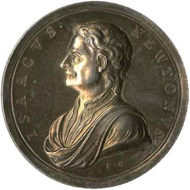by Emily Fildes
courtesy of Money & Medals Newsletter
May 9, 2013 – If I was to mention the name Isaac Newton to you, you might think of alchemy, astronomy or even apples. But your first thought probably wouldn’t be “crime-fighter extraordinaire”. However, during his time as Warden of the Mint (1696-99) that’s exactly what Newton was. As Warden, Newton was the King’s representative in the Mint ensuring that coining was carried out honestly and catching any criminals who were counterfeiting, clipping or otherwise undermining the coins of the kingdom (this was, of course, the days before a police force). Rather than becoming involved in the metallurgy at the Mint, as you might expect, Newton instead threw himself whole-heartedly into the task of bringing to justice those men and women trying to make a dishonest buck.
Commemorative medal depicting Sir Isaac Newton (1642-1727) by John Croker. © Trustees of the British Museum.
Newton was awarded the role of Warden of the Mint by his friend and Chancellor of the Exchequer Charles Montagu in 1696 at a point when he was suffering from a breakdown during his academic research at Cambridge. In offering the job to Newton, Montagu emphasised that the role was honorary and that Newton should not dedicate much time to it. However, after a slow start, Newton appeared to relish it. On the one hand, he made the kinds of contributions you might expect such as using his mathematical abilities to work out how the Mint could increase its efficiency. This was especially relevant as he had joined the outfit in the midst of a huge recoinage. Often attributed to Newton, this recoinage had in fact been the idea of another great thinker of the age, John Locke, in an attempt to stabilise the economy.
At its peak, the Mint had to produce as many coins in a month as it had previously produced in a year, so any attempts to increase its efficiency would have been very welcome. However, it was the crime-fighting aspects of the job to which Newton dedicated the majority of his time. Newton’s records in the National Archives show that during the height of his investigations in February 1699 he spent 10 consecutive days taking witness statements in his attempt to bag his greatest scalp – William Chaloner.
Chaloner was a crafty counterfeiter, rather than hiding in London’s underworld quietly counterfeiting coins, he instead publically accused the Mint of corruption to the Privy Council and suggested his own new method for minting coins – if only he could just get inside the Tower of London to look at the Mint’s machinery. Not long after he had started his job, Newton found himself hauled before the Council to answer to Chaloner’s claims and to prevent him visiting the Mint, finally calling on his Warden’s oath that “the means of minting the kingdom’s coins should be revealed to no man”. This public humiliation pitted Newton against Chaloner and he spent the next two and a half years painstakingly building a case against Chaloner – chasing, interrogating and entrapping his accomplices and their wives. In the process Newton unravelled a huge network of counterfeiting in London and the surrounding counties, and the logic he applied to his questions and the records he kept of their accusations and counter-accusations meant that he had more counterfeiters convicted than any previous or successive Warden. This success meant that on Christmas Day in 1699 he became the first Warden in the history of the Mint to be promoted to the role of Master.
Emily Fildes is Curatorial Assistant, Historic Royal Palaces. This article appeared for the first time in the April 2013 issue of the Money & Medals Newsletter.
Many information about Newton offers the ‘virtual museum of Sir Isaac Newton and the history of science’ newton.org.uk.





